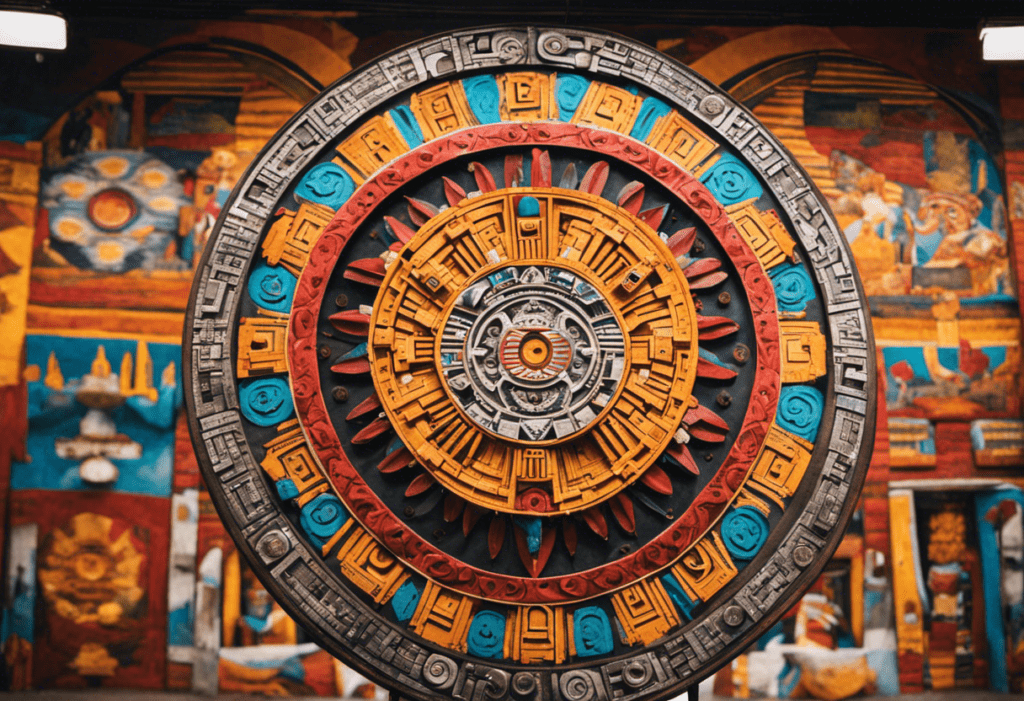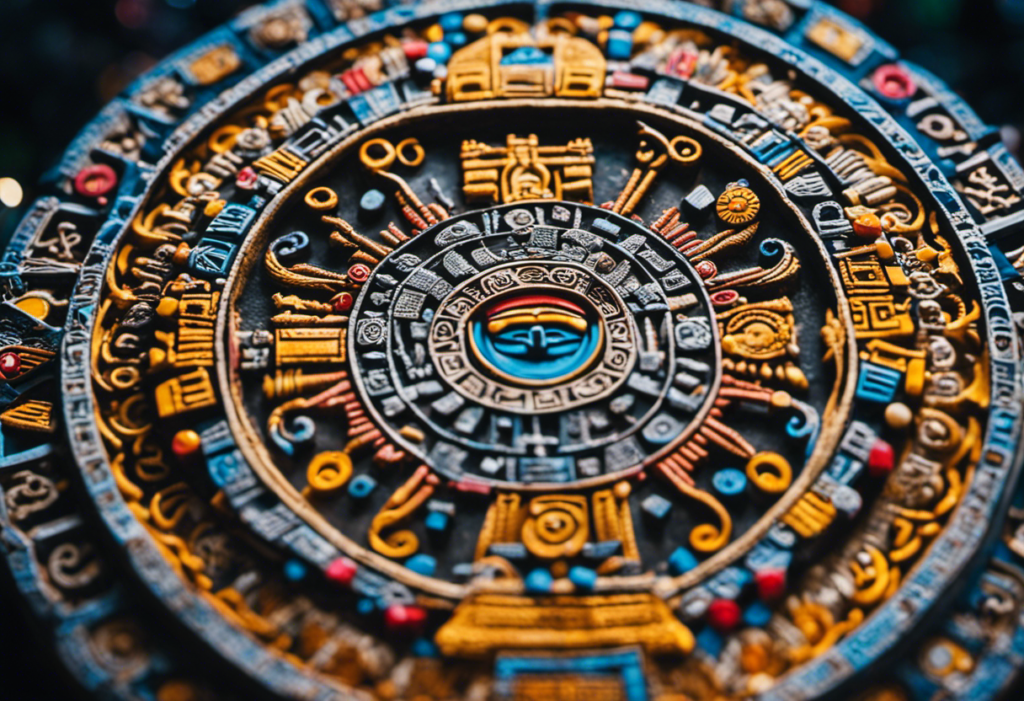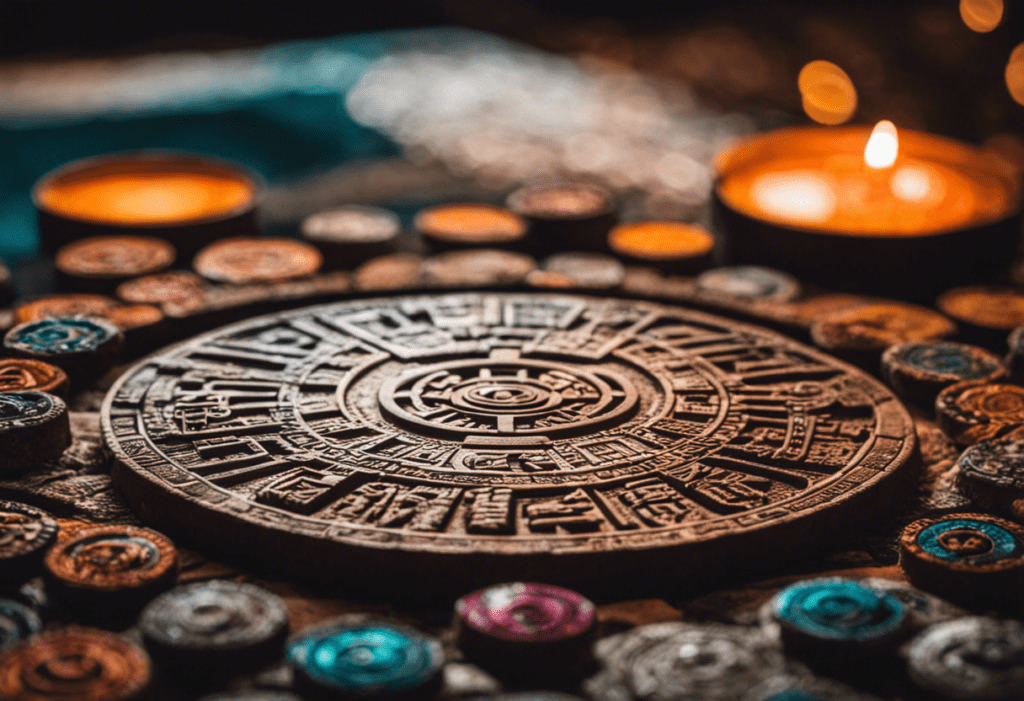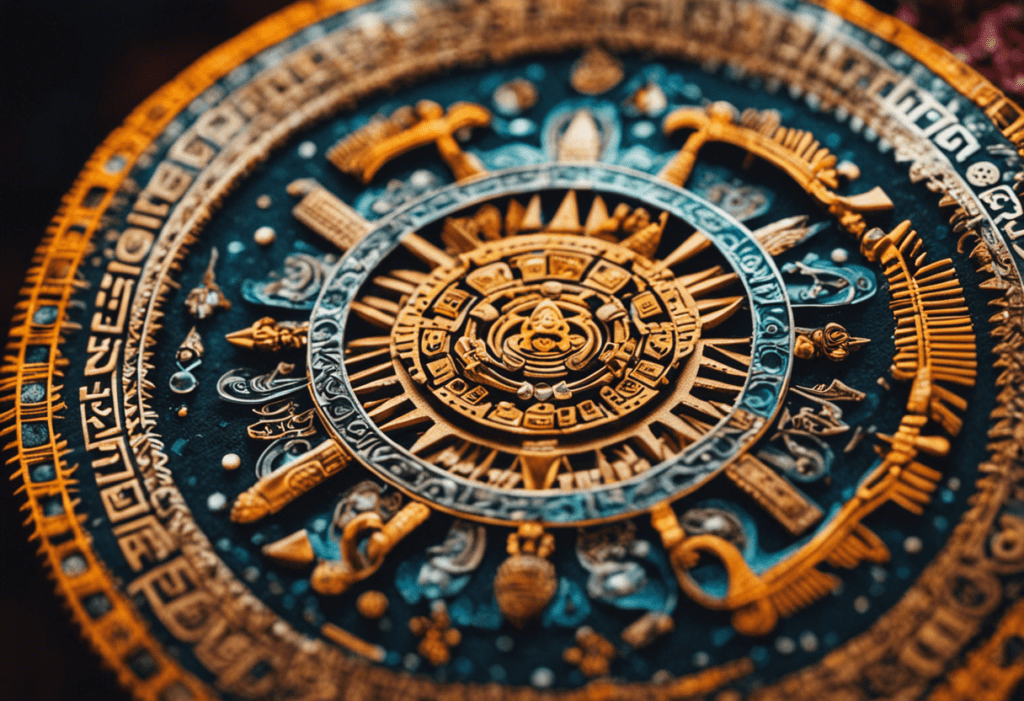The Aztec calendar, a remarkable feat of ancient engineering and timekeeping, continues to leave an indelible mark on modern Mexico. Through its historical significance, influence on art and architecture, and embodiment of national identity, the Aztec calendar serves as a testament to the rich cultural heritage of the region.
This article delves into the rituals, celebrations, and contemporary manifestations of the calendar, exploring its enduring legacy and the efforts to preserve and promote its importance in Mexican society.
Key Takeaways
- The Aztec Calendar holds immense cultural significance in modern Mexico, representing the rich history of the Aztec civilization and embodying the enduring spirit and heritage of the Mexican nation.
- The Aztec Calendar has influenced various aspects of Mexican culture, including art, architecture, fashion, and cuisine, adding a cultural and historical dimension to these areas.
- The Aztec Calendar continues to be prominently displayed during important cultural celebrations, such as the Day of the Dead, and is incorporated into contemporary artworks, fashion, and architecture, highlighting Mexico’s vibrant cultural identity.
- The Aztec Calendar serves as a tool to teach young generations about their history and heritage, fostering a sense of pride and belonging among the Mexican population and playing a role in preserving and promoting Mexican cultural heritage.
Historical Significance of the Aztec Calendar
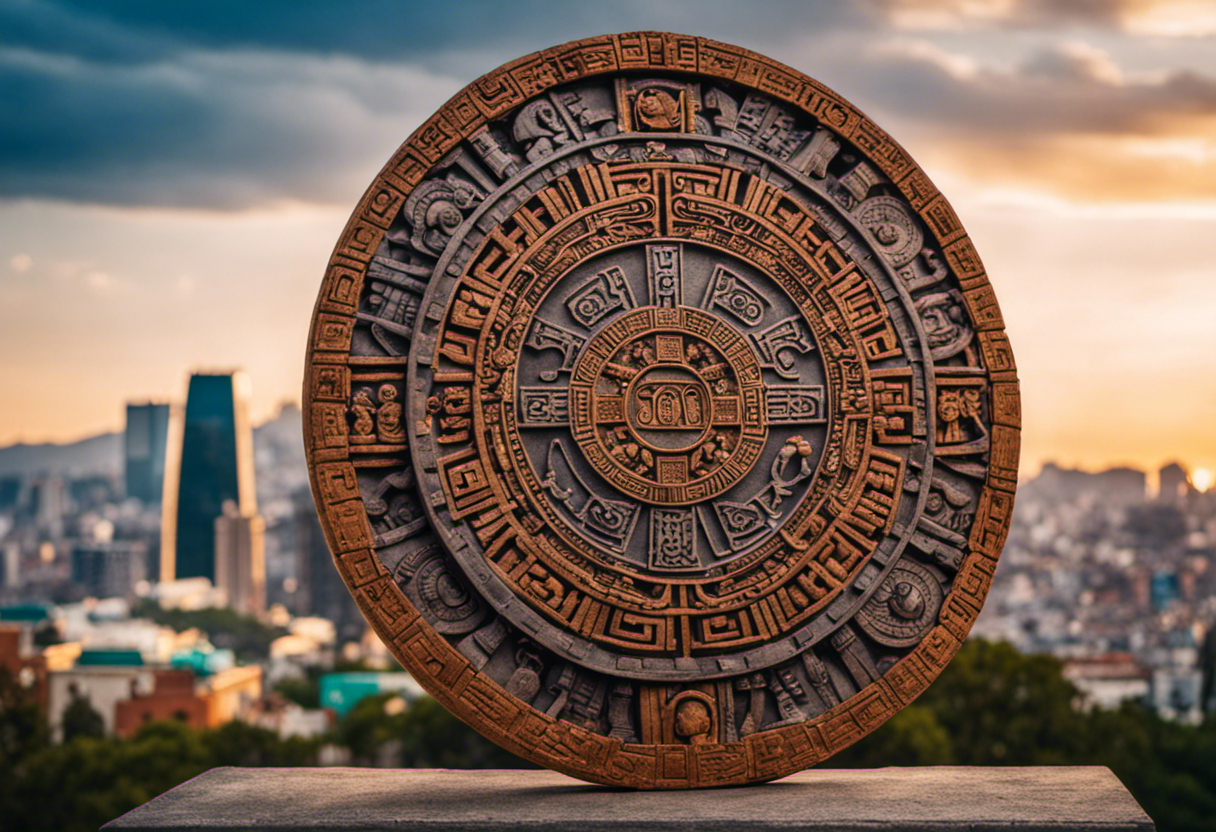

The historical significance of the Aztec Calendar lies in its role as a complex and sophisticated system of timekeeping and religious symbolism. Dating back to the 14th century, the Aztec Calendar, also known as the Sun Stone, was not only a practical tool for measuring time but also a representation of the Aztec worldview and their understanding of the universe. The calendar had a profound influence on Mexican society, shaping their cultural heritage and serving as a symbol of identity and pride.
The Aztec Calendar was more than just a means of tracking time; it was a reflection of the Aztec’s deep connection to nature and their religious beliefs. The intricate carvings and symbolism found on the calendar depicted various gods, celestial bodies, and important astronomical events. This fusion of religious and astronomical elements showcased the Aztec’s profound respect for the natural world and their understanding of the cosmos.
Despite the Spanish conquest and subsequent colonization of Mexico, the Aztec Calendar managed to survive, albeit with some modifications. Today, it stands as a testament to the resilience of Mexican culture and serves as a reminder of the rich history and traditions of the Aztec civilization. Efforts have been made to preserve this cultural heritage, with the Aztec Calendar being prominently displayed in museums and cultural institutions throughout Mexico. It continues to inspire and educate people about the ancient Aztec civilization and their contributions to Mexican society.
The Aztec Calendar’s Influence on Mexican Art and Architecture
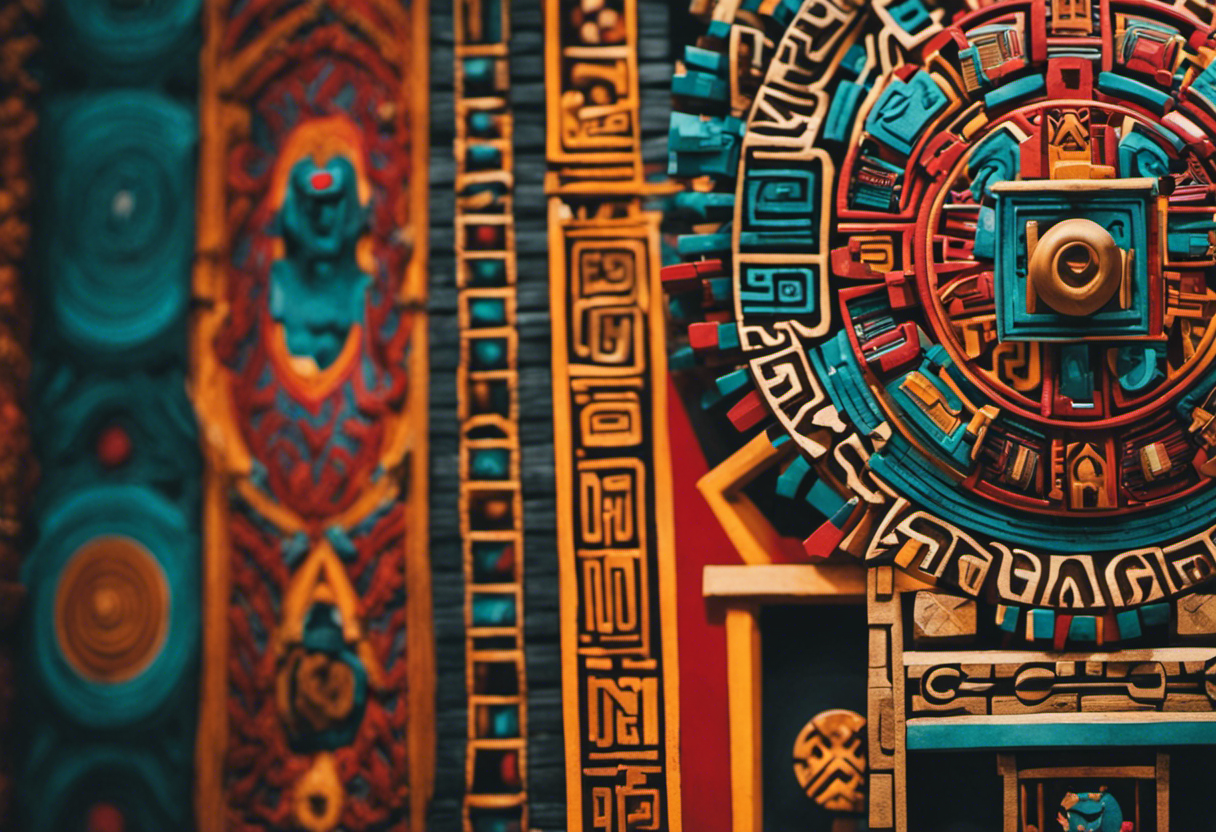

Incorporating elements of the Aztec Calendar, Mexican art and architecture showcase a rich fusion of ancient symbolism and contemporary aesthetics. The influence of the Aztec Calendar can be seen in various aspects of Mexican culture, including fashion and cuisine.
The impact of the Aztec Calendar on Mexican fashion is evident in the use of intricate patterns and vibrant colors. Designers often incorporate symbols and motifs from the calendar into their creations, paying homage to the ancient civilization. This fusion of traditional and modern elements creates a unique and visually striking style that is distinctly Mexican.
Similarly, the incorporation of the Aztec Calendar in Mexican cuisine adds a cultural and historical dimension to the culinary experience. Chefs and food enthusiasts draw inspiration from the calendar’s symbols and use them to create visually appealing dishes that pay tribute to the Aztec heritage. This integration of ancient symbolism into contemporary cuisine not only enhances the aesthetic appeal of the food but also provides a deeper connection to Mexico’s rich cultural past.
The Aztec Calendar as a Symbol of National Identity
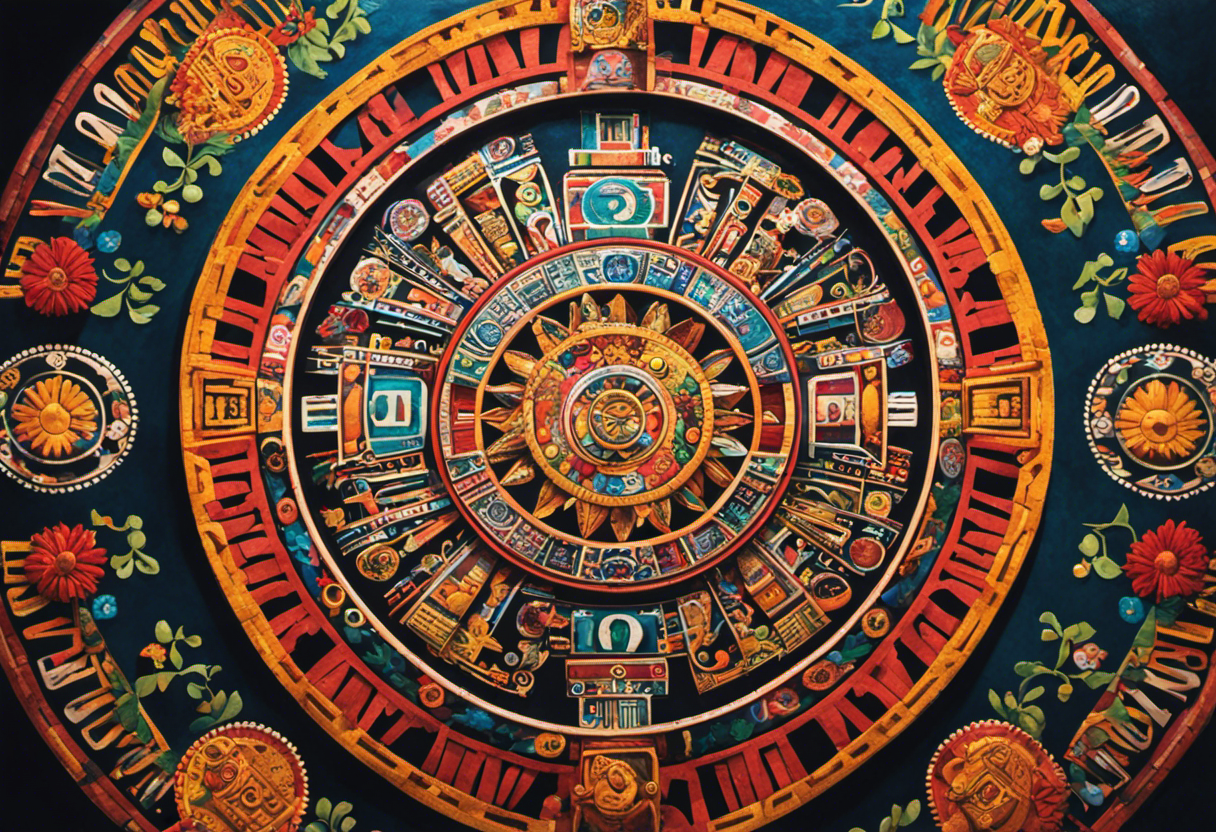

The Aztec Calendar holds immense cultural significance in modern Mexico, serving as a symbol of national identity. Its historical connection with the Aztecs and its symbolic representation of Mexico make it a powerful emblem that resonates with the Mexican people.
This iconic calendar not only represents the rich history of the Aztec civilization but also embodies the enduring spirit and heritage of the Mexican nation.
Cultural Significance Today
Significantly, the Aztec Calendar continues to serve as a powerful symbol of national identity in modern Mexico. Its cultural significance is evident in various ways, including its presence in cultural celebrations and its modern interpretations.
- The Aztec Calendar is prominently displayed during important cultural celebrations, such as the Day of the Dead, where it serves as a reminder of Mexico’s rich indigenous heritage and the cyclical nature of life and death.
- The calendar’s intricate design and symbolism have inspired artists and designers, who incorporate its elements into contemporary artworks, fashion, and architecture. This fusion of the ancient and the modern highlights Mexico’s vibrant cultural identity.
- The Aztec Calendar also plays a role in educational initiatives, as it is used as a tool to teach young generations about their history and heritage, fostering a sense of pride and belonging.
Historical Connection With Aztecs
While the Aztec Empire may have fallen centuries ago, the Aztec Calendar continues to serve as a symbol of national identity for modern Mexico. The historical connection between the Aztecs and the calendar is deeply rooted in Mexican culture and holds significant cultural significance.
The Aztec Calendar, also known as the Sun Stone or the Stone of the Sun, was not only a tool for tracking time but also a representation of the Aztec worldview and cosmology. The intricate carvings on the calendar depict various mythological and astronomical elements, showcasing the Aztec understanding of the universe.
Today, the Aztec Calendar is celebrated and revered as a symbol of Mexican heritage and national pride. It is displayed in prominent locations throughout the country, reminding Mexicans of their rich historical past and serving as a unifying force for the nation.
Symbolic Representation of Mexico
Celebrating Mexico’s rich cultural heritage and serving as a powerful symbol of national identity, the Aztec Calendar continues to embody the deep-rooted connection between the Mexican people and their historical past. As a symbolic representation of Mexico, the Aztec Calendar holds immense cultural significance and evokes a sense of pride and unity among the Mexican population.
The Aztec Calendar represents the rich indigenous history of Mexico, reminding the people of their ancestors’ achievements and contributions to civilization. It symbolizes the resilience and strength of the Mexican people, who have overcome numerous challenges throughout history.
The Aztec Calendar also serves as a reminder of Mexico’s unique cultural identity, distinguishing it from other nations and showcasing its vibrant traditions and customs.
Through its symbolic representation, the Aztec Calendar continues to play a crucial role in shaping Mexico’s national identity and fostering a sense of unity among its diverse population.
Rituals and Celebrations Associated With the Aztec Calendar
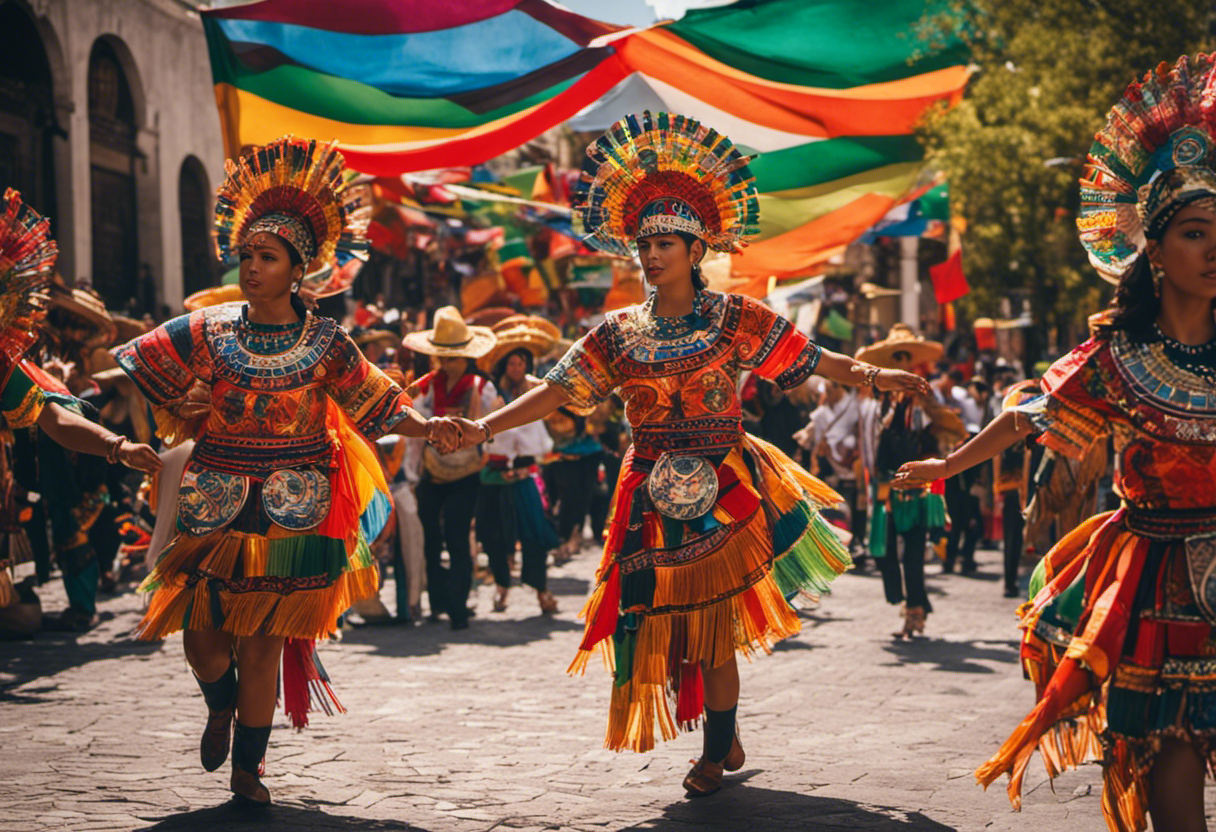

During important religious ceremonies and festivals, the Aztec calendar played a central role in guiding the rituals and celebrations of the ancient civilization. The Aztecs had a deep reverence for time and believed that the calendar dictated the cyclical nature of life and the universe. They celebrated various festivals and performed rituals based on the different cycles of the calendar.
One of the most significant celebrations associated with the Aztec calendar was the New Fire ceremony, also known as the Binding of the Years. This ritual took place every 52 years, marking the end of one cycle and the beginning of a new one. It was a time of great anticipation and anxiety, as the Aztecs believed that the world could come to an end if the gods were not appeased. The ceremony involved extinguishing all fires and then relighting them using the sacred fire. It was a time of purification and renewal for the entire community.
Another important ritual was the Feast of the Sun, which honored the sun god, Huitzilopochtli. This festival took place at the end of the solar year and marked the beginning of the agricultural cycle. The Aztecs believed that the sun needed to be nourished with human blood to ensure the fertility of the land. Therefore, sacrifices were offered to the sun god during this festival.
The Aztecs also celebrated the birthdays of their gods and performed rituals to honor and appease them. These rituals included elaborate processions, dances, music, and offerings of food, flowers, and incense. The calendar served as a guide for determining the timing and significance of these celebrations.
The Aztec Calendar in Contemporary Mexican Culture
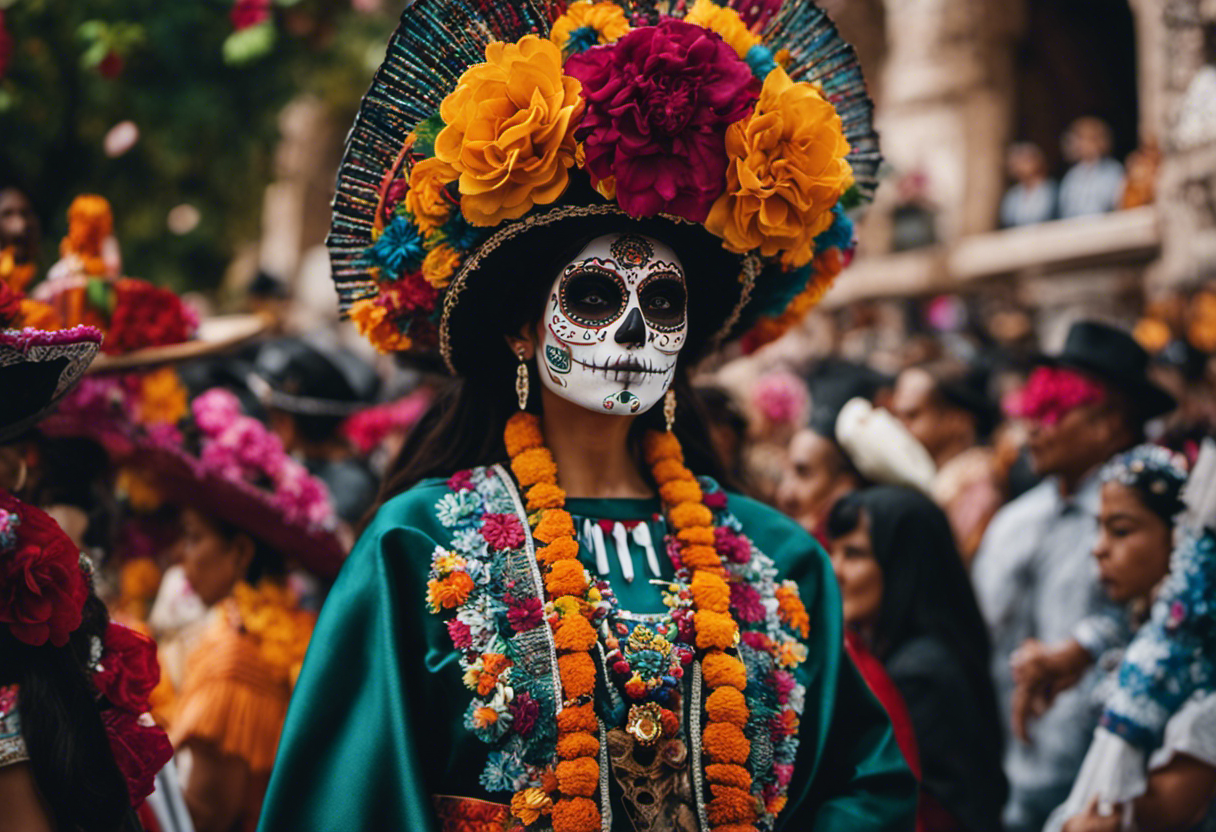

The Aztec calendar continues to influence and shape various aspects of contemporary Mexican culture. It serves as a symbol of national identity and a source of inspiration for artistic expressions. From fashion to cuisine, the Aztec calendar’s presence can be seen and felt throughout Mexico.
- Aztec Calendar in Fashion: The intricate and mesmerizing design of the Aztec calendar has made its way into the world of fashion. It can be found on clothing items such as t-shirts, dresses, and accessories, reflecting the pride and connection to Mexican heritage.
- Aztec Calendar in Cuisine: Mexican cuisine is known for its rich flavors and vibrant colors, and the Aztec calendar has become a popular motif in culinary creations. From decorative cake designs to intricately carved fruits and vegetables, the Aztec calendar adds an element of cultural significance to the dining experience.
- Aztec Calendar in Art: The Aztec calendar continues to be a source of inspiration for artists in Mexico. Paintings, sculptures, and murals often feature the Aztec calendar as a way to pay homage to the country’s indigenous roots and celebrate its rich history.
Exploring the Aztec Calendar at Ancient Sites in Mexico
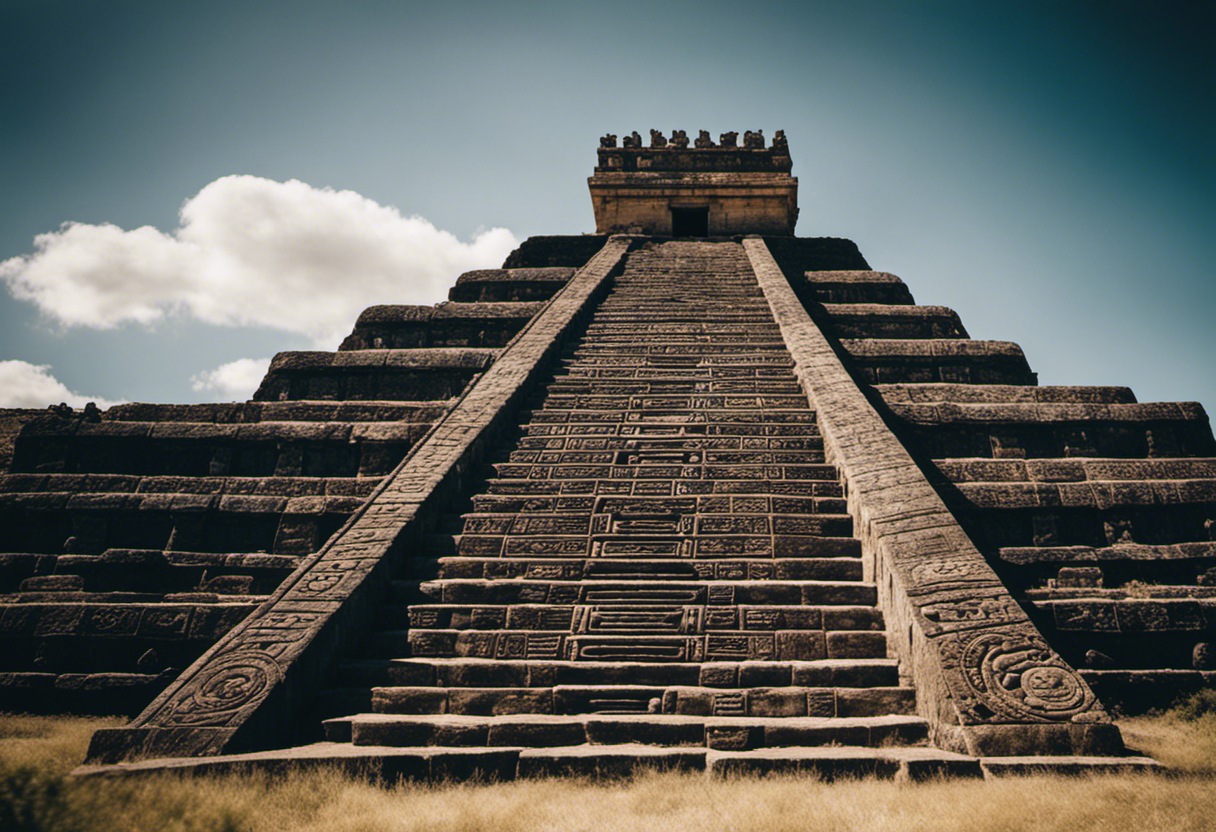

Archaeologists and researchers have extensively studied and documented the intricate Aztec calendar at various ancient sites in Mexico, revealing fascinating insights into its significance and usage in the Aztec civilization. Through the use of exploration techniques and archaeological discoveries, these experts have been able to gain a deeper understanding of how the Aztecs utilized their calendar system.
One of the key exploration techniques used in the study of the Aztec calendar is excavation. By carefully excavating ancient sites, archaeologists have been able to uncover physical remnants of the calendar, such as stone carvings and inscriptions. These artifacts provide valuable clues about the structure and symbolism of the calendar.
In addition to excavation, researchers have also employed aerial photography and satellite imaging to identify and map ancient sites where the Aztec calendar was likely used. This has allowed them to locate specific areas of interest and focus their efforts on uncovering further evidence of the calendar system.
Archaeological discoveries at these ancient sites have shed light on the various ways in which the Aztecs integrated their calendar into their daily lives. For example, researchers have found evidence of calendar stones, known as ‘aztecatl,’ which were used for ceremonial and astrological purposes. These stones were intricately carved with symbols representing the different aspects of the calendar and were considered sacred by the Aztecs.
Preserving and Promoting the Legacy of the Aztec Calendar
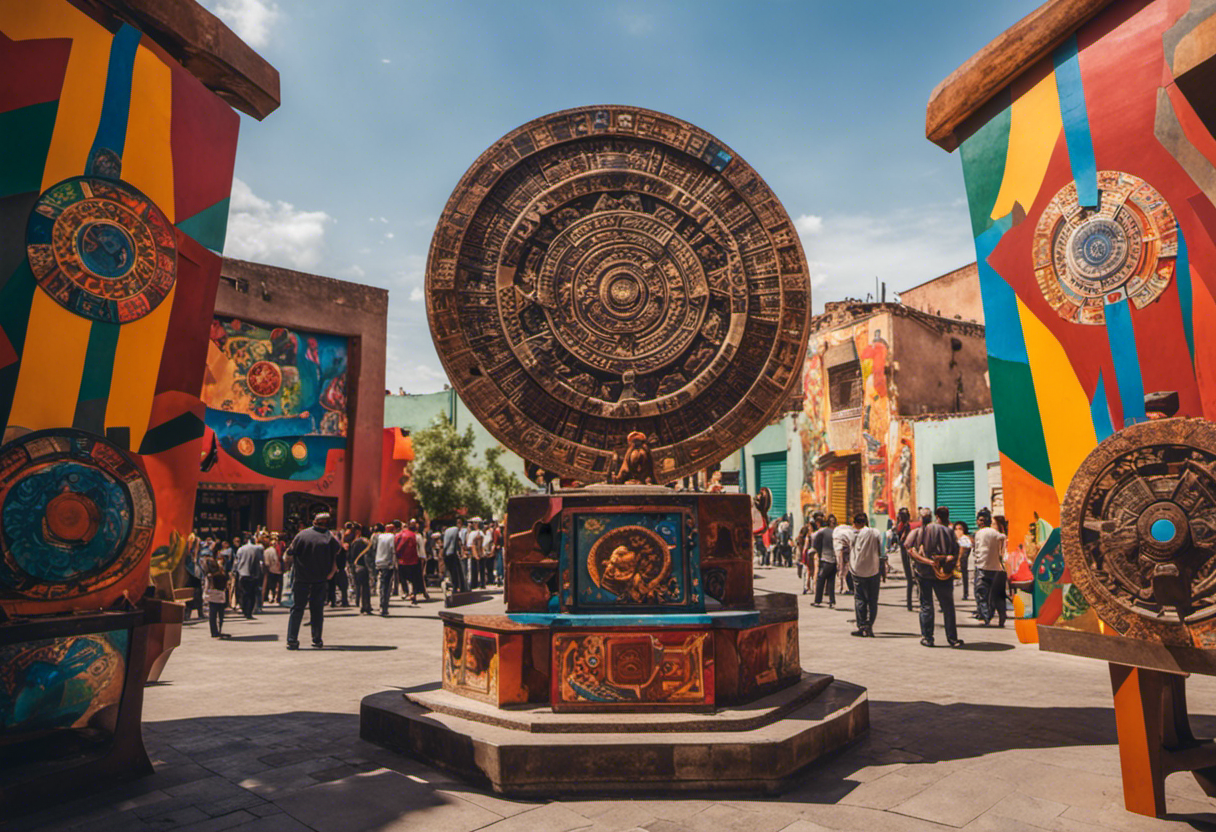

We can actively preserve and promote the legacy of the Aztec Calendar by engaging with local communities, educating the public, and supporting initiatives that highlight its historical and cultural significance.
Preservation efforts are crucial in ensuring the long-term survival of the Aztec Calendar and its associated traditions. By collaborating with local communities, we can involve them in the preservation process, allowing them to share their knowledge and experiences. This not only fosters a sense of ownership but also creates a sustainable framework for the future.
Educational initiatives play a vital role in promoting the legacy of the Aztec Calendar. By offering educational programs, workshops, and exhibitions, we can raise awareness about the significance of the calendar and its role in Aztec culture. These initiatives can target both local residents and tourists, enabling a wider audience to appreciate and understand the calendar’s historical and cultural value.
To evoke an emotional response in the audience, consider the following bullet points:
- Engaging with local communities to preserve the Aztec Calendar, fostering a sense of cultural pride and identity.
- Educational initiatives that bring the Aztec Calendar to life, allowing people to connect with their heritage and history.
- Supporting initiatives that highlight the historical and cultural significance of the Aztec Calendar, ensuring its legacy is celebrated for generations to come.
Conclusion
In conclusion, the legacy of the Aztec calendar continues to shape modern Mexico in various ways.
From its historical significance and influence on art and architecture, to its role as a symbol of national identity and the rituals and celebrations associated with it, the Aztec calendar remains deeply ingrained in Mexican culture.
Its presence can be seen not only in ancient sites throughout the country, but also in contemporary Mexican society.
By preserving and promoting the legacy of the Aztec calendar, Mexico honors its rich history and cultural heritage.

